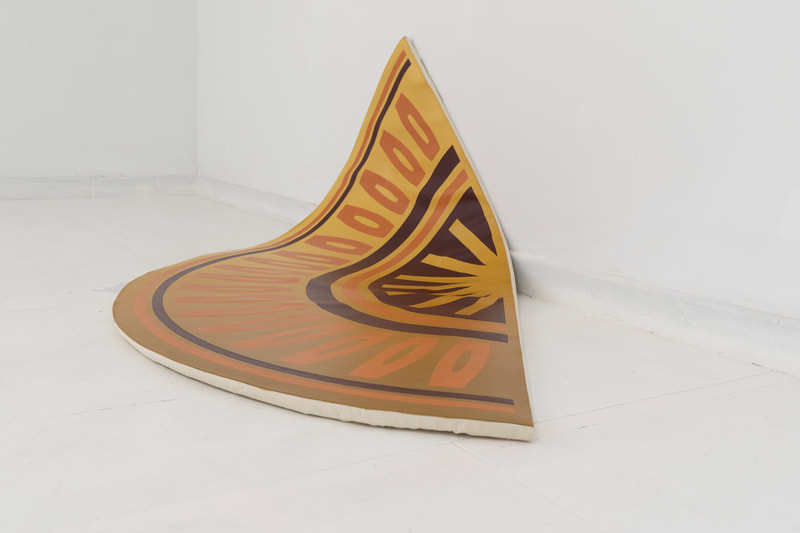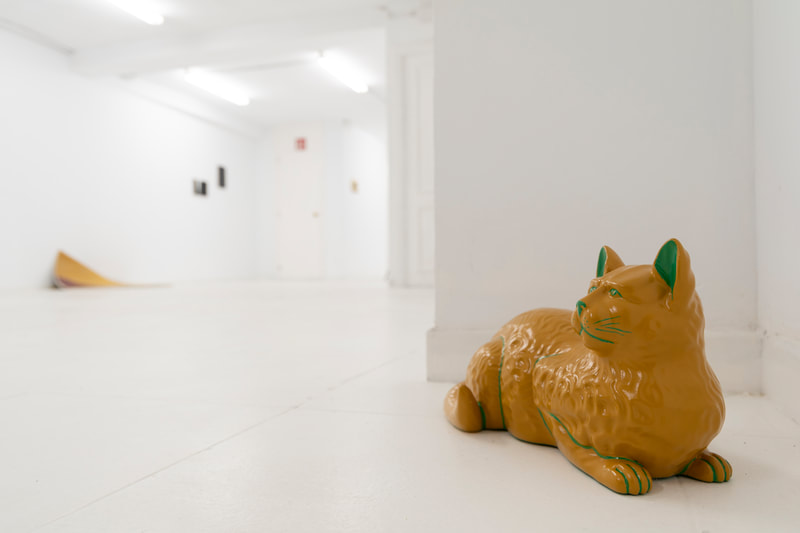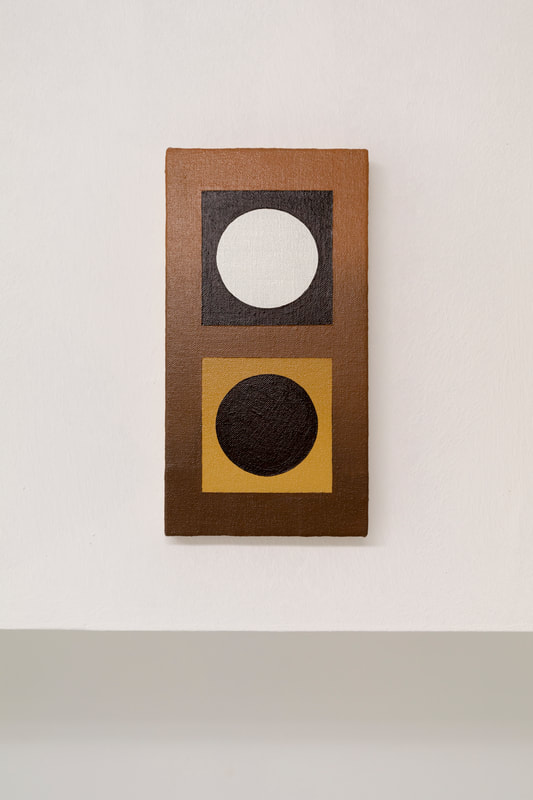LOPE DE RUEDA, 31
JAVIER RODRÍGUEZ LOZANO
13 DECEMBER, 2018 - 07 MARCH, 2019
JAVIER RODRÍGUEZ LOZANO
13 DECEMBER, 2018 - 07 MARCH, 2019
* We kindly ask you not to step on the painting with high heels (o Esos vecinos con felpudos).
A doormat is a highly ordinary subject. And we are going to use that adjective in the sense that the writer Georges Perec confers to it, who is interested in puzzles, because to talk about doormats is... well, too ordinary. It is infra-ordinary. A doormat works as a space in itself. Or even better, as an inter- space.
And again more Perec: “How should we take account of, question, describe what happens every day and recurs everyday: the banal, the quotidian, the obvious, the common, the ordinary, the infra-ordinary, the background noise, the habitual?”
Doormats are species of spaces –we come back to Perec again with that quote, the poor one, as worn-out as a doormat itself-. No one collects doormats –puzzles, some people do-; no one is interested in doormats, except for the one at their own home’s entrance. And even to that one they don’t pay too much attention. But Javier Rodríguez Lozano has developed an extensive interest for doormats. Because doormats give us a lot of information about people.
They are identity marks of their owners, the first image they can transmit of their homes. The infra ordinary, that extraordinary book by Georges Perec, deals with “the meticulous and astonished observation of the daily, and the questioning of what is normally not questioned”. And that is what JRL is curious about and develops in this exhibition.
Doormats are made to send a welcoming rumor. “Step on me, wipe your shoes on me”, they seem to tell us, embracing our fearing feet at the house’s door we are knocking at. And under the doormat, there is a lot hidden: underneath, because it is useful to hide things (a key, a secret note...); behind, because at the other side of the door that the doormat is sheltering as a guard dog, there is a whole private existence. Hidden. On the contrary, JRL has nothing to hide, because this work series is called Lope de Rueda, 31, which is exactly his address in Madrid.
JRL has made a vertical trip through his building’s stairs, scanning all the existing doormats at the doors of his neighbors’ flats in order to copy them on canvas, making –thank’s God- slightly changes when painting them. We also perceive that JRL destroys scales, turning some paintings into mini-doormats, and making others in a giant size, never respecting the original format. JRL paints them delicately, looking after the application of the painting in extreme, with gradient backgrounds of the highest professionalism.
These doormats – I love that word, so used already in this text-, where no one wipes their shoes because mud doesn’t exist anymore in the city, acquire in JRL’s works a pictorial dimension, semi-folded against the wall, hanging as in a formal painting, as an absolutely ordinary canvas. And that is how an object of industrial production is turned into the goal of an exhibition for JRL, who develops an atavistic affection towards an element considered by many as essential at the entrance of the home: the doormat.
Doormats are not for hypersensitive people. They are extremely disturbing objects. A doormat as an evident object and at the same time as a complete distraction that could bring out information about their owners or hide it away completely. We take for granted that owners identify themselves with their doormats. That little extension of the tenants in the staircase, am place that does not longer belong to them, where the doormat is exposed outdoors, to the gentle or evil step, clean or dirty, witness in the landing of the stairs, of what happens in these places, a place much alike for a noir novel...
JRL is attentive and vigilant to the mundane and daily that surrounds us, behind and under these doormats exhibited in the gallery. JRL is working in the vanguard of the research referring to both the domestic and what lays in the street, or to be more precise, on the brink between both scenes, which is exactly where the doormat is.
As the Argentinian poet Tamara Kamenszain says “to spy the sewings in order to see the constructions in the reverse”, that is what JRL devotes himself to.
* JRL doesn’t own a doormat. He is still searching for one he likes. By the way, none of his neighbors knows about this project.
Text by Virginia Torrente
A doormat is a highly ordinary subject. And we are going to use that adjective in the sense that the writer Georges Perec confers to it, who is interested in puzzles, because to talk about doormats is... well, too ordinary. It is infra-ordinary. A doormat works as a space in itself. Or even better, as an inter- space.
And again more Perec: “How should we take account of, question, describe what happens every day and recurs everyday: the banal, the quotidian, the obvious, the common, the ordinary, the infra-ordinary, the background noise, the habitual?”
Doormats are species of spaces –we come back to Perec again with that quote, the poor one, as worn-out as a doormat itself-. No one collects doormats –puzzles, some people do-; no one is interested in doormats, except for the one at their own home’s entrance. And even to that one they don’t pay too much attention. But Javier Rodríguez Lozano has developed an extensive interest for doormats. Because doormats give us a lot of information about people.
They are identity marks of their owners, the first image they can transmit of their homes. The infra ordinary, that extraordinary book by Georges Perec, deals with “the meticulous and astonished observation of the daily, and the questioning of what is normally not questioned”. And that is what JRL is curious about and develops in this exhibition.
Doormats are made to send a welcoming rumor. “Step on me, wipe your shoes on me”, they seem to tell us, embracing our fearing feet at the house’s door we are knocking at. And under the doormat, there is a lot hidden: underneath, because it is useful to hide things (a key, a secret note...); behind, because at the other side of the door that the doormat is sheltering as a guard dog, there is a whole private existence. Hidden. On the contrary, JRL has nothing to hide, because this work series is called Lope de Rueda, 31, which is exactly his address in Madrid.
JRL has made a vertical trip through his building’s stairs, scanning all the existing doormats at the doors of his neighbors’ flats in order to copy them on canvas, making –thank’s God- slightly changes when painting them. We also perceive that JRL destroys scales, turning some paintings into mini-doormats, and making others in a giant size, never respecting the original format. JRL paints them delicately, looking after the application of the painting in extreme, with gradient backgrounds of the highest professionalism.
These doormats – I love that word, so used already in this text-, where no one wipes their shoes because mud doesn’t exist anymore in the city, acquire in JRL’s works a pictorial dimension, semi-folded against the wall, hanging as in a formal painting, as an absolutely ordinary canvas. And that is how an object of industrial production is turned into the goal of an exhibition for JRL, who develops an atavistic affection towards an element considered by many as essential at the entrance of the home: the doormat.
Doormats are not for hypersensitive people. They are extremely disturbing objects. A doormat as an evident object and at the same time as a complete distraction that could bring out information about their owners or hide it away completely. We take for granted that owners identify themselves with their doormats. That little extension of the tenants in the staircase, am place that does not longer belong to them, where the doormat is exposed outdoors, to the gentle or evil step, clean or dirty, witness in the landing of the stairs, of what happens in these places, a place much alike for a noir novel...
JRL is attentive and vigilant to the mundane and daily that surrounds us, behind and under these doormats exhibited in the gallery. JRL is working in the vanguard of the research referring to both the domestic and what lays in the street, or to be more precise, on the brink between both scenes, which is exactly where the doormat is.
As the Argentinian poet Tamara Kamenszain says “to spy the sewings in order to see the constructions in the reverse”, that is what JRL devotes himself to.
* JRL doesn’t own a doormat. He is still searching for one he likes. By the way, none of his neighbors knows about this project.
Text by Virginia Torrente
| (eng_esp) "Lope de Rueda, 31" - Javier R. Lozano |

















